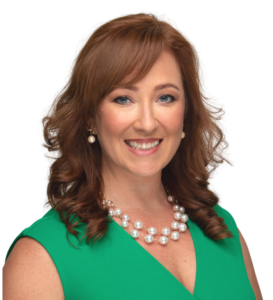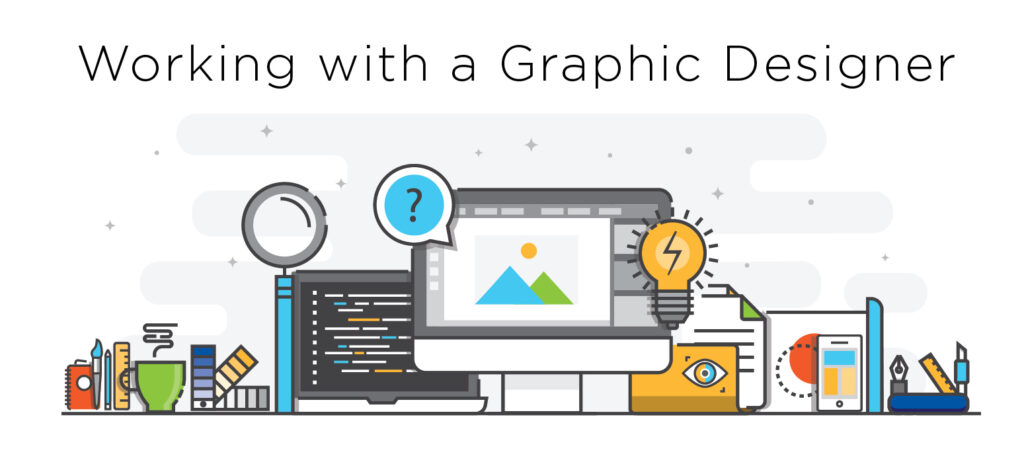Working with a Graphic Designer
A Q&A with Shelly Joines, Partners in Association Management, and Elizabeth Babski, Babski Creative Studios.
Whether you’re building a new brand, promoting a conference to your membership, or launching a new product or service, visual communications are an important part of most successful marketing plans. Unless you have the software and the training to create your own graphics, you’ll probably need to hire professional graphic designers, either in-house staff or an outsourced partner. Don’t know where to start? In this interview with Shelly Joines and Elizabeth Babski, we’ll provide two points of view on what makes a successful design project. Shelly Joines is a long-time Program Manager at Partners and Elizabeth is the owner of Babski Creative Studios
Q: When starting a new graphic design project, how do you define the project’s goals?
Shelly Joines: The more details that you can share upfront with your designer—the better the overall project will be! You’re more likely to be on time and budget if you outline the specific goals, even if it seems like it may not matter or be related. Are you developing a new brand from scratch, a publication redesign or a postcard? How will this fit into your current/future marketing plan (and what branding elements should be included)?
If your project has a defined goal or outcome such as increasing participation in an event or membership renewals —share that! Your designer may have other suggestions. Lastly, let your designer know the distribution method for your project. They will have different parameters for printed vs. digital delivery. What works on your organization’s social media may not be successful in an industry or local printed publication. A printed brochure (printing on front & back) requires an even number of pages regarding layout—whereas an online piece can have even or odd and may save money in layout and design time. Small details are really big ones!
Elizabeth Babski: When I start a new design project with a client, I try to ask questions which kick-start the brainstorming process. Team collaboration and sharing of ideas makes for the best outcomes. Sometimes the client has a strong idea of what they want visually, while other times they only have a marketing goal in mind, and they rely on me to provide visual options. Important project considerations at the beginning of every job are timeline and budget. For example, having worked with many printers in the past, I can usually help steer a client toward the most budget-friendly format for a printed project. I also need to know if we are working with an established brand or if we are developing something new. If the client can share a brand guideline document with me, that helps us stay on track with fonts and colors. It’s also good to know the long-term plans for any given design. If we are developing a brochure cover to promote a conference, it’s helpful to know in advance if they will need trade-show hall signs to match, so that we can plan for the graphics to be scalable for larger printed sizes.
Q: How do you communicate your vision for the completed project’s look?
SJ: Imagine you tell your hairdresser you want long bob and to dye it red. Seems clear enough—but what you may not realize is there are several variances to the exact length of “bob” and what does red hair mean? Does it specify copper, aubergine or in fact a bright red like a specific mermaid? If you walk in with photos of the desired goal and several examples, you’d probably leave more satisfied! The same holds true for working with designers. Utilize Pinterest or Google images to articulate your preferences (or even things you don’t like). Do you have a layout or concept you’re aiming for? Use software like Canva to share a design idea. I use Canva as a digital “cocktail napkin” when communicating. I may not know the difference between infographic and illustration, but if my designer SEES what I want—we’ll get to the finished project quicker—which means saving money and time.
EB: I love it when my clients have example images to help springboard the design process. A picture is truly worth a thousand words in this case! Other references I love to see are inspiration fonts and colors. I’ve had clients clip magazine articles and mail them to me because the font used in an ad for modern furniture is the exact font they wanted for their logo. With today’s font-matching software, we can usually match it, or the sample might spark a whole new idea.
From the other side of the equation, I often do the same for my clients after our initial brainstorming session. I’ll pull together inspiration images, colors, fonts and textures into a project “mood board” which helps the process move from vague concept toward a tangible design. When a client reviews a mood board, they can let me know what works and doesn’t work for them, which helps us move one step closer to the finished look.
Q: Do you consider the market demographics when designing a project?
SJ: Be clear with your designer on the demographics of your clients or potential clients and what marketing channels you will use for distribution. Your designer will need to tailor the final design to catch the eye of your market. It’s not enough anymore to say, “this is a postcard intended for dentists.” Help drive the conversation by sharing, “this is a 4×6 postcard, intended for dentists who are primarily in the Pacific Northwest and between the ages of 45-60.” I can guarantee that the final design for that postcard will have different fonts and layout than a postcard intended for a local philanthropic event targeting families.
EB: Yes, knowing the target audience for any project is key. Also, the product itself has a kind of “personality” that you want to convey and match to your intended audience. Graphic design is just a form of communication—a visual language—so we want to meet the audience where they are, by communicating in the way they can appreciate most. For example, some audiences (younger audiences especially) require bolder colors and more avant-garde approaches to design than others. One thing I keep in mind if I know my audience is older is that they require larger fonts for body text. As someone who has always worn strong corrective lenses, I can appreciate this guideline more and more as I age!
Q: What about workflow? How do you deliver content and view drafts? What’s the best way to provide feedback during the revision process?
SJ: Ask your designer what they prefer! We’ve done scanned pages of brochure edits in red pen, and we’ll do comment notes in PDF format. But I try to ask what is best, so we ensure each edit is caught and amended. Because there’s nothing worse than waiting for a draft to be returned and a request wasn’t addressed—because the designer didn’t understand or see where your note was!
EB: I try to communicate the technical requirements of project content up front. For example, printed photos must be a minimum of 300 dpi (dots per inch) to be reproduced clearly, which is much larger than 72 dpi required for website graphics, like a social media profile photo. So, we work to source good quality images in order for a printed job to look its best. When it comes to the drafting and revision process, the best way to communicate changes depends on what needs to be adjusted. Sometimes we need to troubleshoot the layout of an infographic or another complicated image like a magazine cover, and the easiest way to do that is via phone or Zoom. But often we are just working through small edits to the text portions of documents like magazines or conference programs. For detailed edits like those, I prefer PDF notes or emailed lists, because it provides a reference I can double-check to make sure all changes have been made before I send the next draft for review.
Q: Once the project is done, how do you get the most mileage out of a design?
SJ: If you already asked your designer to create a full suite, you can skip this! But perhaps you have staff or a volunteer that wants to create social media posts, or you want on-property signage and printed materials to have a coordinated look. Then I would encourage you to ask for a “brand sheet.” This will include the hex codes (specific colors data pulled from your logo/design), font names or styles. Just those two elements can make your communications look significantly more professional. This helps build your brand, and consistency will train your clients about who you are and what to expect from you. And isn’t that what communication is about?
EB: Ditto what Shelly said above! Yes, once a client has invested in something like a logo design or conference theme graphics, it only makes sense to use them on multiple platforms. Communicating this up front in the design process is helpful, so that the designer can be sure to provide you with images in multiple formats for use in social media, emails, video, etc. And a brand sheet/brand guide is critical to keeping everyone, like in-house designers as well as future third-party designers, on the same page. I usually provide these at no extra cost for any client working to design a new brand or update and existing one.
Q: Moving forward, how do you keep project designs fresh while staying on brand? Is it important to watch design trends?
SJ: Ask each other! Your designer would be happy to share what they’re seeing in other industries, or for your target market, as well as new technologies and options. But feel free to share what similar organizations within your industry are doing as well so they can learn with you. The design process used to be a short line. But you should think of it as a circle. The projects will eventually end, yes, but share the outcomes and experiences with that campaign to fuel your next endeavor and help your partnership grow and continue growing.
EB: This is both challenging and fun! It can be tempting to get so comfortable with an existing brand style that you don’t try new things. There’s definitely a value to being consistent with your communications to an audience that has learned to recognize your brand. That recognition often equates to “trust.” That doesn’t mean you can’t try fresh approaches to layout, add new companion colors and fonts to your existing brand guide, or develop new ways of communicating information, like using infographics instead of blocks of text. Magazines and newsletters benefit from periodic redesigns as well. As a designer, I try to immerse myself in new art styles all the time, to help keep my eye “trained” for what’s trending. Also, I love it when clients have a fresh idea, and we can make it happen together. Team collaboration creates the best projects.
 Shelly Joines, CMP, has been a Program Manager at Partners in Association Management for 14 years—with the last several years focusing on meeting planning for her state and national trade association clients. A graduate from Florida State University in Communication—she uses her creative side to drive projects, drawing from her passion for photography and art design.
Shelly Joines, CMP, has been a Program Manager at Partners in Association Management for 14 years—with the last several years focusing on meeting planning for her state and national trade association clients. A graduate from Florida State University in Communication—she uses her creative side to drive projects, drawing from her passion for photography and art design.

Elizabeth Babski is the owner of Babski Creative Studios (BCS), a graphic design studio based in Tallahassee, Florida. She’s a graduate of Florida State University, and after working as an association’s communications director, started BCS in 2002. Since then, she has helped many associations and small business clients develop brands and marketing collateral of all kinds.





